From this article you will learn that it gives ordinary solutions refractory properties. We will give examples of manufacture with your own hands. heat resistant mixes From the usual indicating the proportions of ingredients. The article presents prices for raw materials and finished compounds various domestic manufacturers.
Why does the usual cement do not withstand high temperatures? The answer is simple - the fuel is applied in its composition. More precisely, substances that disintegrate during heating. To create compositions with heat-resistant properties, scientists needed to solve only one problem - replace fuel raw materials on non-combustible with similar properties.
Raw materials for refractory compositions
Clay. For the manufacture of 80% of refractory materials, widely used in private construction, use ordinary clay. Even in the form of raw materials seized from the bowels, it has refractory properties, several times the superior properties of Portland cement produced by an industrial method. In this case, the raw material clay does not have the ability to reliably bind the surfaces. Our ancestors perfectly studied the properties of clay and used it for the masonry of Russian stoves and the coating of the walls of the house.
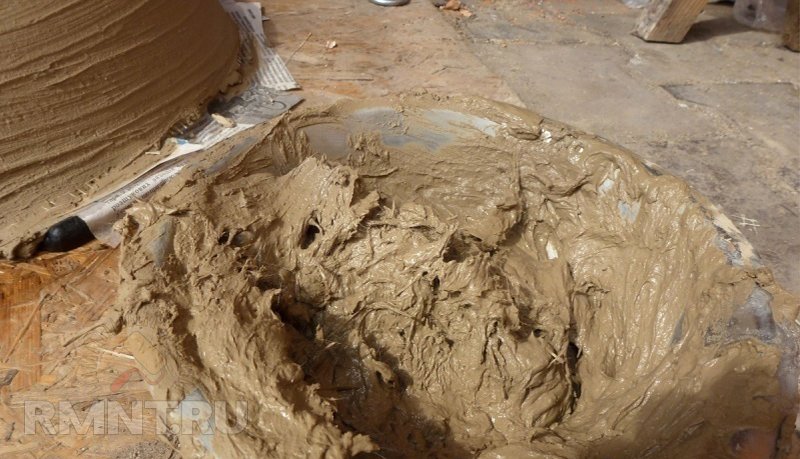
Shamot, Ceramzit. This is a clay that has undergone thermal processing. When baking in the stove, the clay evaporates moisture and loses the opportunity to accumulate it again. Fireproof bricks, blocks and rings for masonry masonry, chimneys, stoves are made from the chamot. In the grinding form, both of these material make up the basis of most refractory factory mixtures.
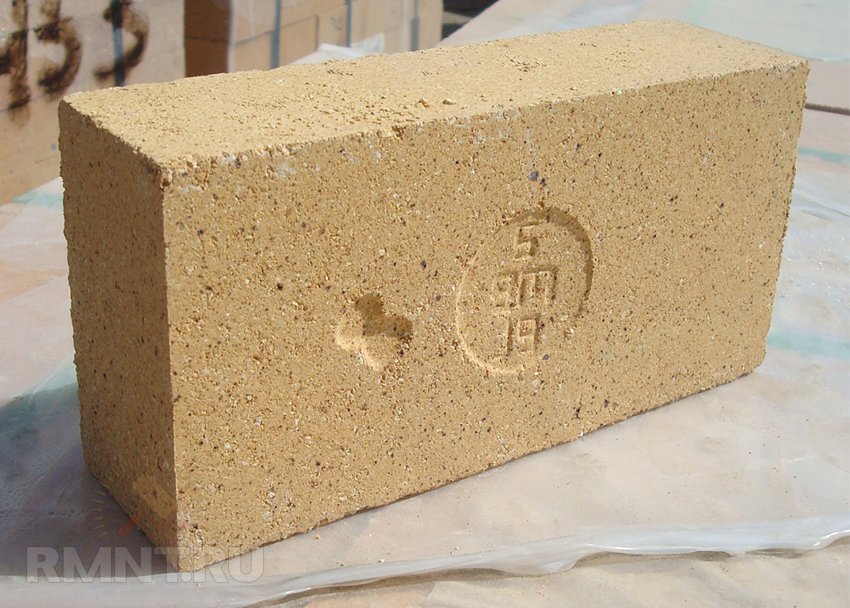
Fireproof and auxiliary raw materials prices
Masonry mix
As mentioned above, for masonry fireproof bricks You can use raw material clay, but the wall thickness should be at least one brick (250 mm). Such a laying has weak stability, the wall is not scattered due to the staticness of the brick, the clay just distributes the load. It is quite acceptable for furnaces and fireplaces inside the house, since the seams do not give shrinkage, and the walls are not deformed.
Another problem is clay - it is hung out of the seam. To give such a masonry strength, a cement-clay solution can be used. His proportions:
- Clay - 2 parts.
- Sand - 1 part.
- Cement - 0.3 parts or 10% of the mixture volume.
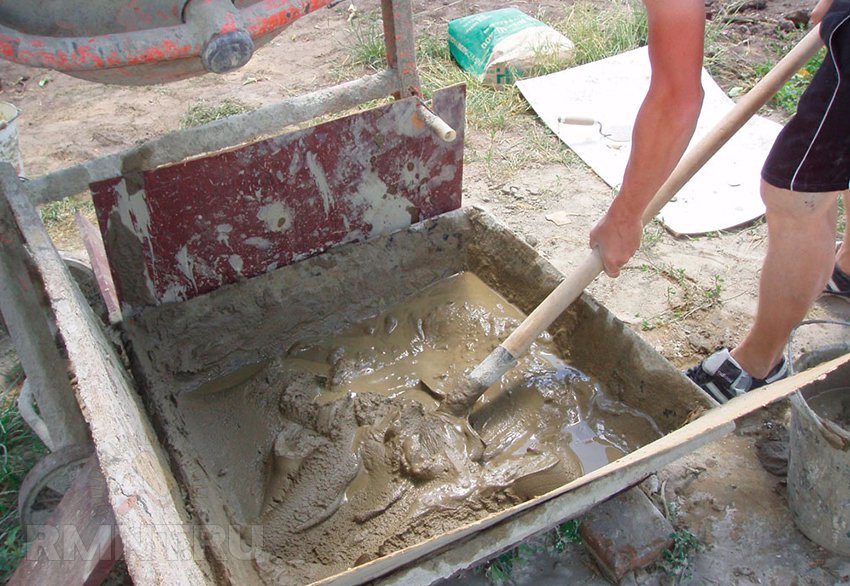
A small amount of cement will help clay to resist in the seams. Such a solution can be called heat-resistant, since it is still present in its composition. fuel material. The cement-clay solution will withstand a temperature of not more than 80-90 ° C.
Of course, the best solution for fireproof masonry With your own hands there will be factory mixtures. Up to 90% of their composition, these metals are ready-made refractory powders, which in different proportions are introduced into the cement-sand mixture. The number of the measureer is calculated depending on the temperature - the higher the greater the percentage of powder. Seam thickness - from 3 to 12 mm.
Fireproof masonry mixes
Fireproof plaster
As in the mixtures of general construction, solutions for masonry and plaster are not much different in the ingredients. The functional difference of a masonry solution from plastering is that the plastering layer is protective, perceives "blows" of the external environment, and therefore should be more enduring (stable).

The easiest and most affordable way to make plaster refractory properties - silication. In practice, this means the addition of silicon glue, in the surprise of "liquid glass". To achieve properties sufficient to use on the inner surface of the furnace or fireplace, 20% of liquid glass is needed from the solution volume. Per 1 cu. M (1000 L) of the solution is needed 200 liters of liquid glass.
Factory refractory plasters and spales are made from kaolin clay, chammed dust (waste of chamotte products) and heat-resistant binder. They are guaranteed to withstand the temperature of 200 ° C.
Factory refractory plasters
Tile glue and mastic
For the manufacture of glue and mastic, a measureer and liquid glass also applies. In essence, such a mastic and is two of these components mixed together. The glue withstands up to 1100 ° C, it is used to clamp visible foci of fireplaces heat resistant ceramic tiles. The mastic is used to fill (grout) of the seams of masonry, exposed to high temperatures, since the masonry solution has much less heat resistance (up to 200 ° C).
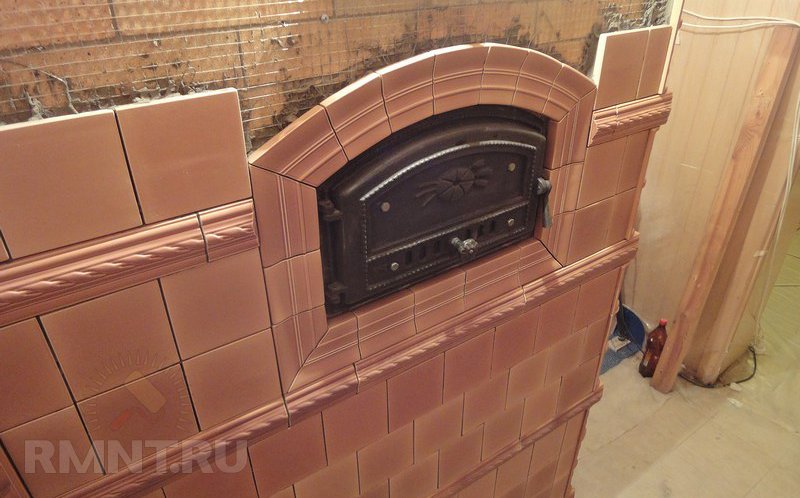
The measureer can be two types - hydraulic and thermal hardening. Hydraulic frozen as ordinary cement mortar. Thermal hardening under the firing, forming a solid ceramic surface (like the clay dishes).
Factory Heat Resisthes and Mastics
| Name of mastic, glue | Manufacturer | Packaging, kg. | Packaging price, rub. | Price 1 kg, rub. |
| KDP-50 (Universal) | Yekaterinburg | 25 | 240 | 9,6 |
| Neomid SuperContact. | St. Petersburg | 4 | 330 | 82,5 |
| HT-7200 | Samara | 75 | 1400 | 18,5 |
| NULLIFIRE F0100. | St. Petersburg | 3 | 180 | 58,8 |
| TriUmf. | Novosibirsk | 15 | 675 | 45 |
Refractory cement
In this kind of mineral binder, calcium aluminate is used, which preserves the strength characteristics of concrete and solutions. Distinctive features of solutions and concrete on heat-resistant cement (in addition to refractory):
- Corrosion resistance. This property is achieved due to the use of inorganic raw materials - calcium aluminate - which is not subject to a rapid natural decomposition (unlike Mergel and lime in ordinary cement).
- The early timing of hardening due to the displacement of moisture from the solution.
- Technological use. According to the method of use and proportions, it does not differ from Portland cement.
- Dielectric properties caused by the absence of moisture.

Making refractory cement is independently impossible, but it is easy to find in a free sale. It allows you to cook refractory concreteThat helps to move away from the canons of masonry fireplaces and embody the most courageous design ideas.
Refractory Cement Prices
In addition to the kaolin clay, refractory properties of dry mixtures give special additives based on silicon, asbestos, barium or other alumina materials. Entering a reaction with water or a catalyst solution, the mass acquires the necessary properties. Another property should be noted that "attached as a bonus" to heat resistance. This is hydrophobization or waterproofing. This is especially true of solutions using liquid glass, which in smaller proportions (10-15%) provides waterproofing properties of a conventional solution.
Vitaly Dolbinov, RMNT.ru
Fireman refractory highlastic "terracot" - Professional masonry composition enriched with aluminum oxide with high plasticity and refractority not lower than 1780 s °. The mixture is used to masonry furnaces from chamotte brick and allows you to perform an intergriptic seam with a thickness of 3-8 mm.
Distinctive properties:
- Heat resistant, environmentally friendly dry mix.
- Keeps its properties when heated to + 1780 ° C.
The consumption of the mixture: depends on the thickness of the seam and approximately 20 kg per 80-100 single bricks.
Structure:
Califle Calin Calin, Flour Chamotte, modifying additives.
Characteristics of the furnace mixture
- mix color: light gray
- heat resistance: + 1780 ° С
- humidity of dry mix: not\u003e 3%
- application temperature: from + 5 ° C to + 60 ° С
- time of complete drying: at least 48 hours
- recommended layer thickness: 3-8 mm
- fractional fraction: no more than 0.63 mm
- recommended amount of indion water by 1 kg of dry mixture: not less than 280 ml
Mix consumption
Depends on the thickness of the seam and approximately 20 kg per 80-100 single bricks.
Cooking method:
Powder mix with clean water room temperature in accordance with the above recommendations. The prepared solution is to withstand for 20 minutes, after which add water to the required consistency and re-mix.
Working with a chimney:
The base should be purified from dust and dirt, lumps of mortar, old plaster, oil and emulsion paint residues. Red chimney brick in front of the masonry to hold under water for at least 3 minutes, chamoten brick does not require wetting.
Works are performed at a temperature of from + 5 ° to + 60 ° C. Recommended layer thickness 3-8 mm. It is necessary to apply the solution with a trowel or a celma, the decay of the seams on the brick is carried out immediately during the masonry work. The first heating is recommended not to produce not earlier than 48 hours from the end of the masonry work to a temperature not higher than + 300 ° C, in the subsequent time the temperature and time are not normalized. When the solution thickening is thickening, you must additionally add water and mix.
Packing and storage
Available in bags of 20 kg. The use of the mixture is not limited. The mixture retains its properties after freezing and defrosting.
Refractory is called a heat-resistant cement, relating to alumina or high-aluminum materials. The solution prepared on its basis is characterized by increased solidification rate in an aqueous and air environment and special strength.
Features and characteristics
The refractory cement has the following characteristics:
- Turning resistance. Racks to temperature increase to 2000-3500 ° C.
- Strength. With an increase in the temperature of heating, ceramic clips, which give particular strength to the material are formed. Also, an increase in this characteristic affects the percentage ratio of cement in solution. What is more, the stronger the mixture.
- High speed. A record compared to others and the opportunity to operate the resulting product after 20 hours.
- Couplings and viscosity. According to criteria fireproof species Cement is not inferior to the usual one.
- Corrosion resistance. Thanks to the calcium aluminate used refractory solution Not susceptible to rapid decomposition and corrosion.
- Non-electrically conductive properties. Due to lack of moisture.
- Manufacturability of use. Proportions and methods of application this material Much differ from Portland cement.
- Easy cooking process. To make the solution, you can only mix cement, sand and water.
Fireproof differs from other types of cement, for example, from slag or portland cement, degree of confrontation with elevated temperatures. So almost any view at T 250 ° C is deformed, and at 500 ° C cracks and burst, which negatively affects the integrity of the structure. The refractory cement even at 2000 ° C retains its initial properties.
Glind-grade cement is produced by the brands of Hz-40, Hz-50, Hz-60. The main consumers are fuel and energy enterprises, building complexes of defense significance. The most common brands of high-grade cement of the HCC-I-35, HCC-75-05. They have increased refractory indices, in comparison with Hz-40 and Hz-50 and during operation do not distinguish an unpleasant odor.
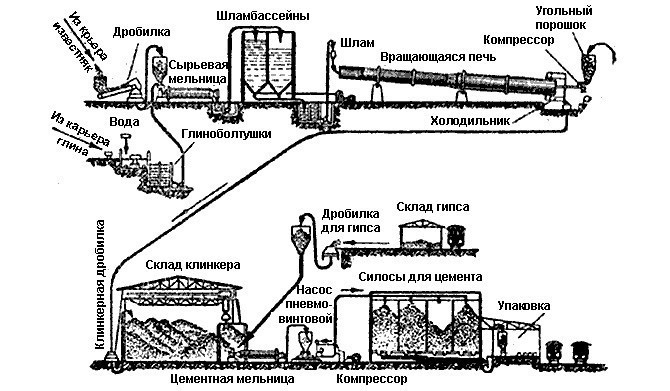
Hz and HCC are made using alumina by smelting and compared with portland cement are more fire-resistant, and in a mixture with fillers such as magnesite or chromite ore, can be used to obtain hydraulically hardening solutions.
Unlike Portland cement, the period of solidification of which is 1-3 days, refractory grabs no more than 10 hours. It hardens well in a humid environment, and when adding to concrete makes it waterproof and frost-resistant. However, in order to avoid recrystallization, it needs to provide the necessary humidity during the day with optimal temperature mode.
The refractory alumina cement is characterized by an increased density compared with other types. He is also more resistant to negative influence aggressive media. However, the heat-resistant cement is deformed under the influence of alkali, so it is not recommended to mix it with lime or plaster.
Scope of application
Refractory species is used for the manufacture of heat-resistant construction mixesused when installing and repairing furnaces, fireplaces and chimneys. Also, with the use of Hz and HCC, cellular concrete, coating, masonry solutions, bricks and blocks, characterized by special strength are made. Refractory mixtures for furnaces and fireplaces have increased thermal resistance and crack resistance.

Dry mixes based on heat-resistant cement are successfully used for repair and restoration work at a lining of thermal units in various industrial sectors. Also fireproof materials Find application when creating monolithic structures, special followers and dry mixtures. They are almost indispensable for concrete work In the cold season, when can be used without heating at temperatures up to -10 ° C, and for the manufacture of non-shrinkable materials. They are used both in ferrous metallurgy and in color (in the aggregates of smelting of various metals).
The heat-resistant cement is used as an ingredient in the manufacture of solutions and adhesives in the construction chemical and refineries. It is used in devices in the production of phosphorus, ammonia, various alcohols. It is also suitable for building mines, underground structures, foundations for cars. The refractory mixture can be applied in the energy sector for the manufacture of burner stones, glass furnaces and other products that differ in high strength.

Since in comparison with Portland cement, the heat-resistant material has a short time of setting, it can be used in urgent repair work on the house. Also with the help of it is preparing the base under the floors, window sills and perts.
Cost of cement
In order to buy high-quality cement, it is necessary to pay attention to the brand and the availability of certificates of product conformity. The heat-resistant material in contrast to the usual has a higher price, as it is specialized. The table presents approximate prices for the most popular brands of refractory cement. The value of the material may vary depending on the season (in the summer prices are increasing, the winter is reduced).
The refractory concrete due to special characteristics is successfully used both in housing construction (in the manufacture of fireplaces and furnaces) and in industrial. You can buy it in bags or in bulk, both in bulk and retail.
It is used for masonry from refractory (chamotte) brick of industrial and household furnaces and fireplaces, with a working temperature up to 1750 ° C.
How to use a mixture of refractory oven?
Before starting masonry, brick must soak in water. Then there is a small amount of refractory mixture (1-2 bag) and falling asleep into the container. Constantly stirring the mixture, water is added in small parts. According to consistency, the clay solution should be so that when laying a brick, it could easily be squeezed under the severity of the brick itself and under his hand at him.
The seam of the clay solution must have a thickness of 3-5mm - the thinner of the seam, the stronger the masonry. The hardened solution of the refractory mixture in the masonry has a degree of expansion when heated, equivalent to refractory (shamoth) brick, since the mixture is made on the basis of refractory (chamotte) clay, which will avoid cracks in the masonry during the operation of the furnaces.
One bag of the mixture is enough to put an average of 35-40 bricks.
Weight 25 ± 0.2 kg.
TU 1523-001-0148977766-2006.
What is part of the furnace refractory mixture?
1.Porch refractory clay for TU 1522-009-001190495-99;
2. Single for construction work according to GOST 8736-93;
3. Forming according to GOST 2138-91
There are several distinctness of the refractory mixture of the furnace.
It can be:
Clay solution for furnaces – fireproof mixThe main binder of which is clay, and the filler is natural sand, the maximum grain size is 1.5 mm. It is easy to use, has high technological properties.
Used to masonry wood stoves and chimney pipe From the burned brick indoors.
Appearance of this mixture for furnaces:
-powder;
- gray gray;
-Mimal temperature - use + 5 s;
-Akakka 25 kg;
-time use is a ready solution for 3 hours;
-Maximum size - grains of 1.5 mm;
-Kol-in water approx. 5 l per 25 kg of dry mix;
Ready solution 15 l / 25 kg;
Consumption 0.8 kg / full brick (257x123x57), 1.0 kg / hollow brick (257x123x57)
Masonry work with a gloss solution for furnaces is not recommended at ambient temperature less than + 5 ° C. The temperature of the brick and the solution should also be more than + 5 ° C, the brick must be dry and water. The masonry should be made from 10 - 13 mm seam or with an open seam for subsequent filling with a mixture in the production of masonry work should comply with the relevant standards for conducting masonry and designers.
After the end of the masonry work temperature ambient Must be maintained above + 5 ° C for at least 5 days. Prior to use, the design should dry for 2 to 3 weeks with open dampers and valves. The first cautious heating is carried out, for example, blowing warm air. The following 3 - 5 days heated with low fire. The flaps and valves leave open after each drying heating.
Fireproof masonry solution – mix of refractory oven, the main binder of which is soluble glass, and filler - quartz sand., Maximum grain size is 0.5 mm. Such a mixture is easy to use, has high technological properties. Heat resistance + 1200 ° C.
It is used for masonry inside the focus of wood stoves indoors.
Appearance: Powder
-Mimnal temperature use + 5 ° C;
- gray gray;
-Akakka 25 kg;
-Time use of the finished solution for several days, subject to storage in a closed container; -
-Maximal size - 0.5 mm grains;
-Kol-in water approx. 4.5 - 5.0 l per 25 kg of dry mix;
- prepared solution 12 - 13 l / 25 kg;
Consumption 0.25 kg / brick;
Heat resistance + 1200 ° С
Storage Storage time in a dry place - approx. 1 year.
It is not recommended to carry out work at ambient temperature less than + 5 ° C. The temperature of the brick should also be more than + 5 ° C, the solution is higher than +10 ° C. The masonry should be made from 1 - 2 mm seam.
Chemical grasp solution occurs at room temperature, ceramic - at a temperature of + 700? P. Prior to use, the design should dry for 2 to 3 weeks with open dampers and valves. The first cautious heating is carried out, for example, blowing warm air. The following 3 - 5 days heated with low fire. The flaps and valves leave open after each drying heating.
Refractory mass – mix of refractory oven, the main binder of which is the aluminate cement, and the filler is a chamotte clay, the maximum grain size is 5,0mm. The mass is easy to use, has high technological properties. Heat resistance + 1300 ° C.
It is used for refractory fills and repair inside foci of stoves, fireplaces, grills, etc.
Appearance - powder;
Gray color;
Minimum temperature - use + 5 ° C;
Packaging 25 kg;
Use time - ready solution 1 hour;
Maximum size - grains 5,0mm;
Number of water 2.5 - 3.5 l per 25 kg of dry mixture;
Ready mass 11 - 12 l / 25 kg;
Heat resistance + 1300 ° С
Storage Storage time in a dry place - approx. 1 year
It is not recommended to carry out work with this mixture at ambient temperature less than + 5 ° C. The minimum thickness of the filling layer of extensive places is 50 mm, when pouring the arch - 100 mm. It is impossible to reinforce, because The thermal expansion has become more than the thermal expansion of the mass for the fill. The mass of mass begins after 2 - 5 hours.
Prior to use, the design should dry for 2 to 3 weeks with open dampers and valves. The first cautious heating is carried out, for example, blowing warm air. The following 3 - 5 days heated with low fire. Dampers and valves leave open after each drying heating
Refractory mixture for furnaces It is not included in the nomenclature of products of services subject to mandatory certification and declaration of conformity. When stored, the refractory mixture is not afraid of humidity. The shelf life is not limited.
By purchasing a refractory mixture of the furnace in OOO OGNEUPOREnergokholding, you are guaranteed to get a quality product. Here you will find a wide range of refractory mixtures.
We will be happy to be useful for you!
Refractory mixture - overview of her species
Is an an important element in safe operation furnaces and fireplaces. It is designed for laying internal structures in fireplaces, home wood furnaces, chimneys and other objects, the operation of which is carried out under high temperatures. A simple dry mixture is not suitable here, as it does not have such an important function as fire safety. Therefore, that the repair process of your heating structures does not drag on for a long time, you need to understand which solution is better to use for your purposes and how to do it correctly.
A mixture of refractory is a few species: a clay solution for furnaces, refractory masonry solution and a refractory mass for fill. At the same time, they have various advantages and characteristics, but still icing can be performed by any of these compositions.
All unformed refractories, as seen from their name, are manufactured without complying with any form or size. They can be represented in the form of powder, paste, suspension or fibrous materials. Accordingly, each represented refractory mixture may be dry, semi-dry, plastic and liquid flow. At the same time, each oven refractory, regardless of its type, is able to withstand the temperature differences up to +1650 degrees and not to ignite. Such dignity of refractories provides a special heat-resistant composition.
IN clay solution For furnaces, the main binding element is a refractory clay, and the filler is natural sand. Such a refractory dry mixture is easy to use and has excellent properties. It can be used for laying furnaces and pipes indoors.
As an example of such a mixture, a refractory solution manufactured by Vetonit can be brought. Unformed refractories of this manufacturer, unlike many others, after dilution with water can be used within a few days. While the products of most competitors intended for furnaces and fireplaces should be used during the day, and even 4 hours.
Another example of a high-quality product is a refractory mixture of Borovichi with a multi-year story. This refractory mixture has a clay and high quality sand. This heat-resistant solution is able to withstand temperatures up to +1750 degrees. Its main purpose is for furnaces and fireplaces indoors.
Another refractory, presented in the form of a masonry solution, is soluble glass as a binder, and the role of the filler performs quartz sand. The use of such a mixture is sufficiently simple and efficient, but most of all it is suitable for the inner masonry of the focus and can be used indoors.
There is still a huge amount of fireproof for masonry of furnace structures.
Quality refractory masonry mix It is manufactured using aluminate cement and special heat-resistant aggregates. Sometimes for plasticity, the chamotte ingredient is added to them. A good example of such a solution is the alummy cement - a modern refractory dry mixture, which is the best hydraulic material. Such a means is used to get a refractory solution and concrete. Fire resistance is purchased after shame and magnesite is added to the alummy cement. Best tool This category is the product of Hermes.
Some manufacturers using a mixture of refractory aggregates and a clay cement created even more durable material - refractory concrete. Such a refractory after frozen turns into a solid material, like a stone and retains all its properties for a long time.
CBS Company - a large manufacturer of building and finishing materials has a wide range of refractory mixtures of various purposes in its product line. First, it is a refractory dry mixture, the purpose of which is a masonry work associated with high-temperature modes. Secondly, a mixture containing a shamot - bonding component required for solutions used in masonry and intimidation. Thirdly - fully prepared for use of an elastic solution in the form of mastic. This solution, due to its versatility, greatly facilitates the entire repair process. It is suitable for masonry and surrounding and plastering. In addition, the KBS enterprise was able to select components in such proportions so that the composition was frost-resistant and for a long time did not lose its precious advantages.
Each refractory masonry mixture has high physical propertieswhich due to the high grip strength allow it to remain stable to the formation of cracks.
For finished furnace Or the fireplace will certainly require cladding with tiles or a stone to emphasize all the beauty. Here again can come to the rescue special heat-resistant dry mix. Some manufacturers in the assortment present there is a refractory adhesive type of mixtures, which also has excellent data. Since the composition of such an adhesive mixture is held in the strictest selection, then they are presented in the market in a small assortment.




